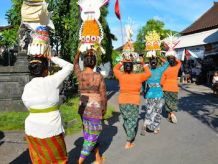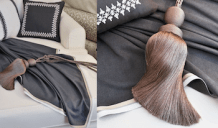
Paris Photography Exhibition, Juifs du Maroc, Showcases Imagery of Departed Jews of Morocco
Morocco is home to one of the largest Jewish populations that once existed in the Arab world. In the 1940’s Morocco had over 350,000 Jews living within its Imperial Cities and rural regions. In celebration of this unique history, the Museum of the Art and History of Judaism (mahJ) in Paris will offer a rare insight into the Jews of Morocco through an exhibition that showcases 60 black-and-white photographs and drawings by the late French photographer and painter Jean Besancenot.
Besancenot traveled to Morocco several times between 1934 and 1937. He photographed the rural Jewish communities of Morocco that have now disappeared.
Jean Besancenot attended the School of Decorative Arts in Paris, began a career as a painter, and studied regional French costumes. During a study trip to Morocco in 1934, he took up photography with an interest in traditional clothing. With help from the Ministry of Foreign Affairs, he stayed there in 1935 and 1936, photographed men and women from different communities, and carefully documented their ceremonial costumes.
Jean Besancenot explored the southern regions of Morocco that were lesser affected by the West known for being a melting pot of Berber and Jewish communities that date back to antiquity.
This rare and phenomenal exhibition culminates original prints that were constructed by Besancenot along with those culled from both public and private collections.

The co-curator behind “Juifs du Maroc” is Hannah Assouline. Assouline is a French photographer, born in Algeria, with over 30 years of experience. She currently resides in Paris.
What makes this exhibition particularly special for Assouline is the story behind how and why her father, Rabbi Messaoud Assouline’s, the photograph is displayed within it.
According to an article published by the Museum of the Art and History of Judaism (mahJ), Hannah Assouline met Jean Besancenot in 1985, which marks the year of her interest in photography. Assouline told Arab News with “as soon as Besancenot saw me, he immediately knew where I was from. He told me, ‘You come from Tafilalet (a region in southern Morocco) and you are a Jew.”
Excerpted from an article featured on the Museum of the Art and History of Judaism (mahJ) website:
Assouline claims, “I wanted to buy pictures from him, but since I didn’t have enough money, I couldn’t buy a lot,” she continued, adding that Besancenot had 2,800 photographs portraying the Jewish world of Morocco. “He showed me more than 100 pictures — all of the Jewish people, among them, were many girls and young women.”
Assouline came across a snapshot from 1935 of a very young married couple and noticed that the boy resembled one of her nephews. Intrigued, Assouline purchased the photograph — along with six more as gifts for her siblings — and was eager to show it to her family.
“I went to my parents’ home to show them the pictures on a Friday night, which is Shabbat,” she said. “My father was very religious and didn’t want to see the pictures on Shabbat. When he finally agreed to look at the pictures, he said in Arabic: ‘It’s me!’ He had never seen this picture before — it took him 50 years to see it. He went through exile, war, moved to a new country with a new story, and, in the end, he found his picture.”
It turned out that Assouline’s then-13-year-old father — timid and barefoot — was only playing the part of a groom and was photographed in Erfoud, one of the centers of Moroccan Jewish life at a time when the North African country was a French protectorate.
The reason why Besancenot was exploring and documenting these closed-off regions was that he was commissioned by the Foreign Ministry and the then newly built Musée de l’Homme in Paris to carry out ethnographical work — through detailed notes, films, and colorful drawings — of traditional Moroccan clothing. In the publicity for the exhibition, the museum notes of the female costumes and adornments that their “repertoire is sometimes common with that of Muslim women.”
The presence of Jewish women dominates Besancenot’s work. Their imposing headpieces and voluminous layering of necklaces, earrings and bracelets were central to their identity, beauty, and in some cases, social status. “In some of the pictures, you’ll see women wearing torn, old clothes but they’re still wearing all their jewelry,” Assouline noted.
“I love the pictures because Besancenot was a real human,” she said of the photographer’s compositions. “He took pictures without judgment. The pictures are very sensible and he was very close to the sitters. He came often to Morocco to see the people. It was not a one-time shoot – he came day after day to talk with everyone and then he took the pictures. The exhibition is set between 1934 and 1937, but he always came back to Morocco. All his life, he circled around that country.”
Along with his photographs, Besancenot films, draws, and takes numerous notes, which introduce him to the then very active milieu of French ethnology. In 1937, his work was exhibited at the Musée de la France d’Outre-Mer, in the Palais de la Porte Dorée, inaugurated in 1931 during the Colonial Exhibition. He presents photographs, a choice of paintings, as well as some costumes and jewelry. He also collaborates with the Musée de l’Homme, to which he offers five hundred and fifty documented photographs, as well as clothing. In 1942, he published Costumes et Types du Maroc, a work reproducing his drawings enhanced with watercolor which remains an essential reference on traditional Moroccan clothing.





